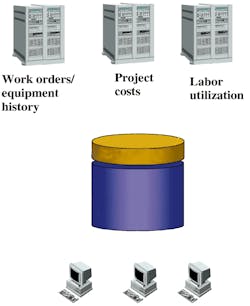In the final application, users will be able analyze such maintenance information as work orders, costs, and labor.Chevron Products Co. is implementing enterprise resource planning (ERP) solutions for refining maintenance activities.
Two of its refineries-at Richmond, Calif., and El Segundo, Calif.-are piloting the new maintenance-planning systems.
Broadbase Information Systems Inc., Menlo Park, Calif., has been contracted by Chevron to develop a software application with which Chevron can analyze maintenance data. The application will be based on Broadbase's Enterprise Performance Management (EPM) solution.
The objective is to allow Chevron to measure its performance against key metrics, to discover safety and environmental compliance trends, and to optimize refinery assets and labor utilization.
As Chevron and Broadbase are still in the process of developing software for Chevron, users have found numerous additional applications for the data.
Scope and objective
Like most refineries, Chevron has a collection of maintenance data in various forms. The data include work orders, equipment histories, costs, purchases, planning, scheduling, contracts, and preventive maintenance information.In 1996, Chevron used two companies, Meridium Inc., Roanoke, Va., and Indus International Inc., San Francisco, to consolidate its maintenance data into one system. Chevron then used the data to predict equipment life and to develop preventive maintenance tasks based on statistical trends and reports.
In May 1998, at the National Petrochemical & Refiners Association Maintenance Conference in San Antonio, Chevron reported an estimated 20% drop in maintenance expenses as a result of planning and scheduling in conjunction with the new database at its six U.S. refineries.
In late 1998, Chevron invited Broadbase to expound on what Meridium and Indus had developed. Broadbase was asked to create an application that would allow further manipulation of the data.
The final application will give management more insight into overall refinery performance by leveraging data on labor, materials, and reliability to perform business simulations and "what if" analyses. With results from these analyses, managers can make more-informed maintenance and business decisions.
The new system will provide historical, comparative, and predictive information.
Historical and current information can be trended. Questions about underlying causes of information can be found using a "drill-down analysis." This allows proper analysis of data. Finally, predictive functions allow the user to anticipate equipment situations.
The application that Broadbase is developing will have an interface that is seamless to employees retrieving and analyzing data. Users will access popular computer programs, such as Microsoft Access or Microsoft Excel.
Eventually, Chevron envisions that all employees will have access to maintenance data. The company is considering putting these data on its Intranet system.
"Our objective is to uncover hidden reliability issues that can cause problems and losses down the line. The business analysis solution from Broadbase has the potential to improve our reliability and ensure that the highest standards are met, while avoiding lost profits," said Sam Preckett, reliability focused maintenance systems manager for Chevron.
Analysis in action
Today, Chevron has been working with Broadbase using snapshots of experimental data to test the program. In about 3-6 months, Chevron expects that this ERP system will be completed and ready for actual use.Preckett pointed out that the software can also help with continuous improvement.
The following example illustrates one situation in which the data can be used.
Maintenance supervisors daily plan and update maintenance jobs. These plans can vary from 1 day in advance to several months.
In the program, the supervisor inputs the name of the craftsman, his various tasks, necessary materials and cost, and an estimated time of completion.
Provided the database has been updated regularly, the database system allows the supervisor to easily attach an equipment's repair history to the work schedule, giving the craftsman more information and more initiative.
After the craftsman has finished his tasks, the craftsman enters the actual tasks, timing, and costs into the computer. By comparing actual work vs. planned work, a supervisor can continually improve his ability to schedule work accurately.
Today, there is no such systematic way a supervisor can tell how well he has adhered to the schedule. Provided the data are diligently entered, in the future, Chevron expects that all managers will be able to access the shared scheduling system and analyze how well the schedule was planned.
For a small refinery, said Preckett, 100-200 contractors cost about $70,000/day. Thus, total maintenance for all six refineries is over $420,000/day. These numbers make even a small improvement worth a great deal in effectiveness.
Copyright 1999 Oil & Gas Journal. All Rights Reserved.

